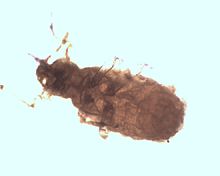Pemphigus spyrothecae
| Pemphigus spyrothecae | |
|---|---|
 |
|
| Pemphigus spyrothecae under microscope | |
| Scientific classification | |
| Kingdom: | Animalia |
| Phylum: | Arthropoda |
| Class: | Insecta |
| Order: | Hemiptera |
| Family: | Aphididae |
| Subfamily: | Eriosomatinae |
| Genus: | Pemphigus |
| Species: | P. spyrothecae |
| Binomial name | |
|
Pemphigus spyrothecae Passerini, 1860 |
|
Pemphigus spyrothecae, or the poplar spiral gall aphid, is a social insect which exhibits apparent altruistic behaviors. The aphids form galls and act as colony defenders, at times sacrificing their own lives to do so. It has been shown that colony defense is more likely in habitats that are difficult to obtain and can hold a large number of individuals. These gall locations are so crucial because plants have a short window in which a gall can be produced. Thus, it is important for there to be a defense system that enables organisms to retain their galls. The need for defense arises when the gall is opened up to allow winged aphid migrants to leave and to release any waste. The process of repairing the holes, in P. spyrotheca, can take up to 10 days; during this time, the gall is susceptible to intruding predators.
P. spyrothecae is green, red or yellow in color and smooth to the touch. The outer surface of this species develops as the edges of the petiole of Populus nigra thicken, flatten and twist. In parallel to the petiole's shape, a gall forms into a spiral shape similar to that of the inside of a snail's shell. The fundatrix, or parthenogenetic female aphid produced on the primary host plant from an overwintering fertilized egg, is pale green; these individuals allow the second generation alatae to form within the gall. The Galls typically mature in late August to early September and change color from green to red over the course of maturation. At this stage, the alatae exit the gall through many small pores along the spirals' seams. In terms of geographical distribution, P. spyrothecae are distributed across Europe, North Africa (Tunisia), western Siberia, Pakistan and some locations within Canada.
Pemphigus spyrothecae is in the superfamily Aphidoidea, in the hymopterous division of the Hemiptera order, which consists of insects with sucking parts of the mouth. P. spyrothecae is a member of the suborder, Sternorrhyncha, which includes scale insects, psyllids, whiteflies, aphids. These organisms have two pairs of membranous wings and a flexible forewing, along with an herbivorous diet. As a member of the Aphididae family, which consists of the aphids or plantlice, this species consists of soft-bodied insects that live in colonies on their host plants. Furthermore, the Aphididae include winged or wingless forms, with six-segment antennae. Every species of this family has a dual-segmented tarsi with the second segment having two claws. A pair of short cornicles protrude from the last abdominal segment, in addition to the cauda, a posterior projection on the tip of the abdomen.Pemphigus spyrothecae is included in the genus Pemphigus.
...
Wikipedia
